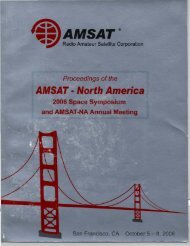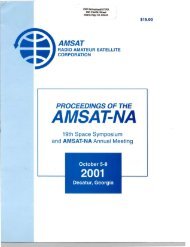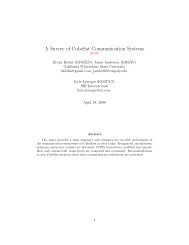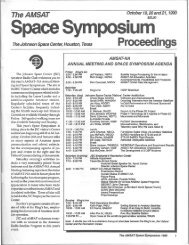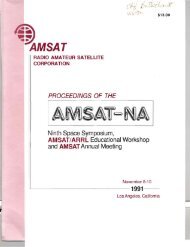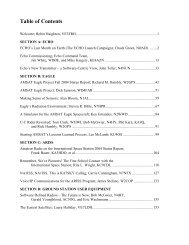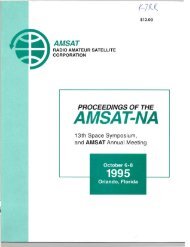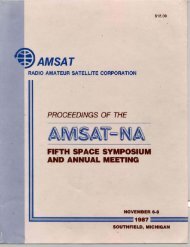October 27-29, 2000 - Klofas.com
October 27-29, 2000 - Klofas.com
October 27-29, 2000 - Klofas.com
You also want an ePaper? Increase the reach of your titles
YUMPU automatically turns print PDFs into web optimized ePapers that Google loves.
The satellite controller board contains a latchup detection circuit. Being in orbit, the processor is exposed to high<br />
energy particles. Eventually, the processor will be hit by a high energy particle and have one or more transistors<br />
latched in an improper state. This can cause the processor to draw a large amount of current. The latchup detection<br />
circuit is designed to detect a sudden increase in current and cycle the power to the processor. Cycling power clears<br />
up the latchup. Not all high energy particles cause a latchup. Some will cause a bit flip called a single event upset<br />
(SEU). An SEU can cause data to be corrupted or program execution error. The circuit designed uses a MAX890L<br />
high-side current switch. The MAX890L allows the current limit to be set with an external resistor. When the<br />
current exceeds the limit, the device will cycle the power. The MAX890L is used to detect current increases greater<br />
than 200 milliamperes. Even though the PIC processor consumes less than 40 milliamperes during normal<br />
operations, the total dose radiation effects need to be considered. As the processor is exposed to radiation, the total<br />
dose accumulation will cause the processor to increase its power consumption over time. Total dose radiation testing<br />
showed that the processor consumed 180 milliamperes at its end oflife. In the case that a smalliatchup occurs where<br />
the current increase is less than the limit, the voltage from the MAX471 current sensor is monitored for changes. It<br />
is possible for a latchup to occur in the processor and the processor to still operate. Software would be used to detect<br />
the smaller current changes. If the current change is determined to be a latchup, the processor can stop pinging the<br />
external watchdog timer. The watchdog timer is a MAX824. If it is not pinged within 1.6 seconds, it will cycle the<br />
power with a MOSFET transistor. If an SEU causes data or program execution to be corrupted, the processor will<br />
stop pinging the watchdog timer. All of these devices are connected in series. The MAX890L is connected to the<br />
power bus. Next, the MAX47 I current sensor is connected to the output of the MAX890L. The MOSFET transistor<br />
is connected to the output of the MAX471. The two Maxim parts can support of to 1 ampere of current. The power<br />
through each Maxim part is through a very low impedance resistor. The voltage drop is insignificant. The<br />
<strong>com</strong>bination of hardware and software provide a robust latchup and SEU detection system.<br />
The PIC controller underwent radiation testing at the Naval Research Laboratory. Exposing the die to a laser<br />
performed Latchup and SEU testing. The laser is used to approximate high energy particles. Latchup was<br />
determined to occur at about 17 MeV. When exposing certain parts of the die, the processor continued to operate<br />
during a latchup event. The maximum current measured during a latchup was 600 milliamperes. The PIC controller<br />
was never damaged by a latchup. The SEUs occurred at about 2 to 3 MeV. It took little energy to flip bits. Exposing<br />
the EEPROM to the laser actually induced program execution errors. None of the EEPROM bits could be flipped by<br />
laser exposure. The maximum energy level exposed was about 300 MeV. Even at this high energy level, no damage<br />
was induced. When the watchdog timer was exposed to the laser, it stopped working. It was not able to reboot the<br />
processor. An external watchdog timer is needed. For total dose testing, the PIC controller was exposed to an x-ray<br />
source. The x-ray source was calibrated so that it could be correlated to a cobalt-60 radiation source. The PIC<br />
controller failed after being exposed to 20 Krads. The failure was due to the EEPROM being set to all zeros. The<br />
PIC controller could be reprogrammed. For a second exposure, the PIC controller was exposed to and additional 15<br />
Krads before <strong>com</strong>plete failure. The PIC controller couldn't be reprogrammed after the second exposure.<br />
The fITst payload will be a picosat attitude control experiment. The payload will control the spacecraft<br />
magentorquers. It will have magnetic field sensors for each axis. The processor architecture will allow for software<br />
uploads. The processor will need to be fast enough to calculate orbital position from time and uploaded keplarian<br />
elements. At this time, one of the newer faster versions of the 80C52 eight bit processors has been selected. It can<br />
access external memory and peripherals. If the experiment is successful, then a more <strong>com</strong>pact version of the 80C52<br />
can be used. Radiation hardened versions of the 80C52 do exist for those who need longer duration missions.<br />
Subsequent satellite designs will incorporate the attitude control on the satellite controller.<br />
3.1.4 Satellite Structure Evolution<br />
When the group started designing the CubeSat, the group went through a few design evolutions. The initial design<br />
specification early in the program was for a 3.5 inch cube. The design was highly modular. There are only two<br />
different types of panels. All of the side panels are identical. Each panel is made of lI8-inch aluminum. The center<br />
area is machined out to allow for mounting of a solar panel and magnetorquer coil. The inner sides of the panels<br />
have rails machined to allow mounting of the circuit boards. The top and bottom panels are designed to deploy<br />
antennas. The antennas are constructed ofpiano wire and wrap around a racetrack machined in to the top and bottom<br />
panel. A solar panel can be mounted on the panels. The panels also provide shielding for the RF electronics. The RF<br />
circuit board mounts to the panel. The <strong>com</strong>ponents are oriented into the panel cavity. The circuit boards are stacked<br />
and can slide into a partially assembled structure using the rails on the side panels.<br />
<strong>29</strong>



